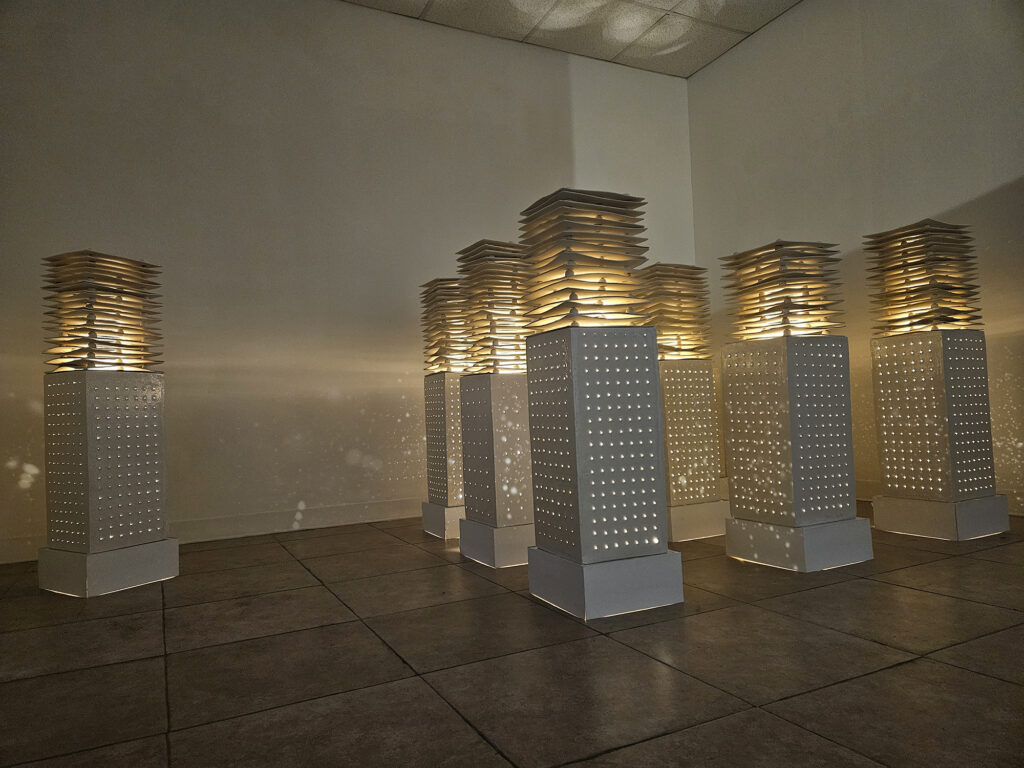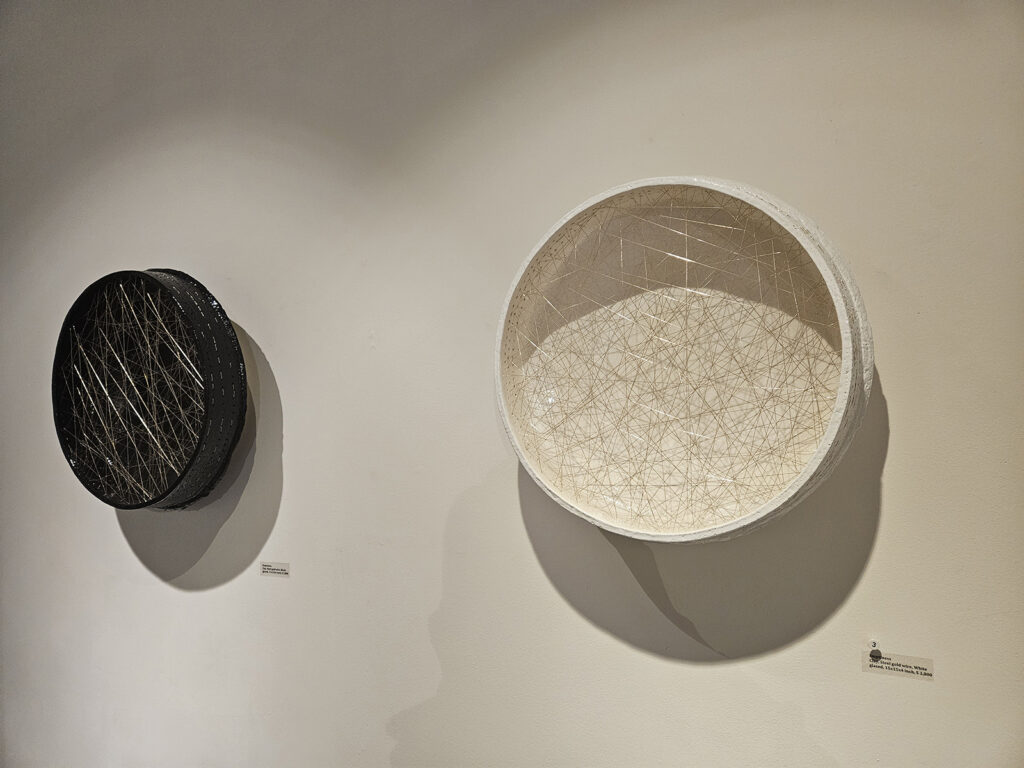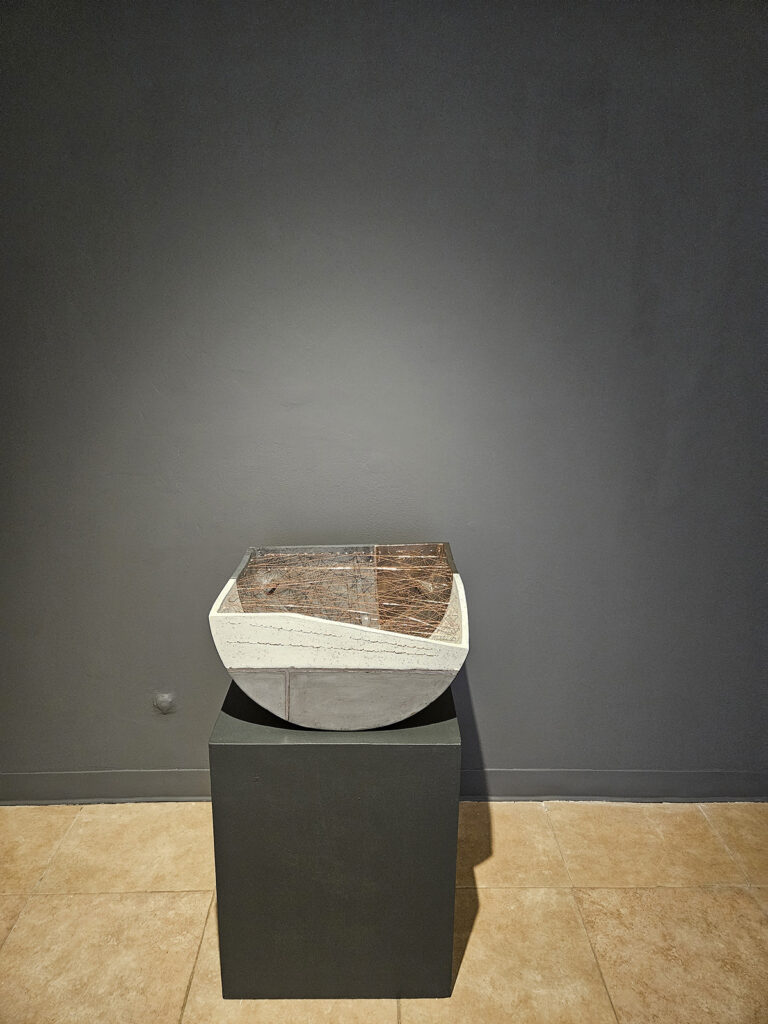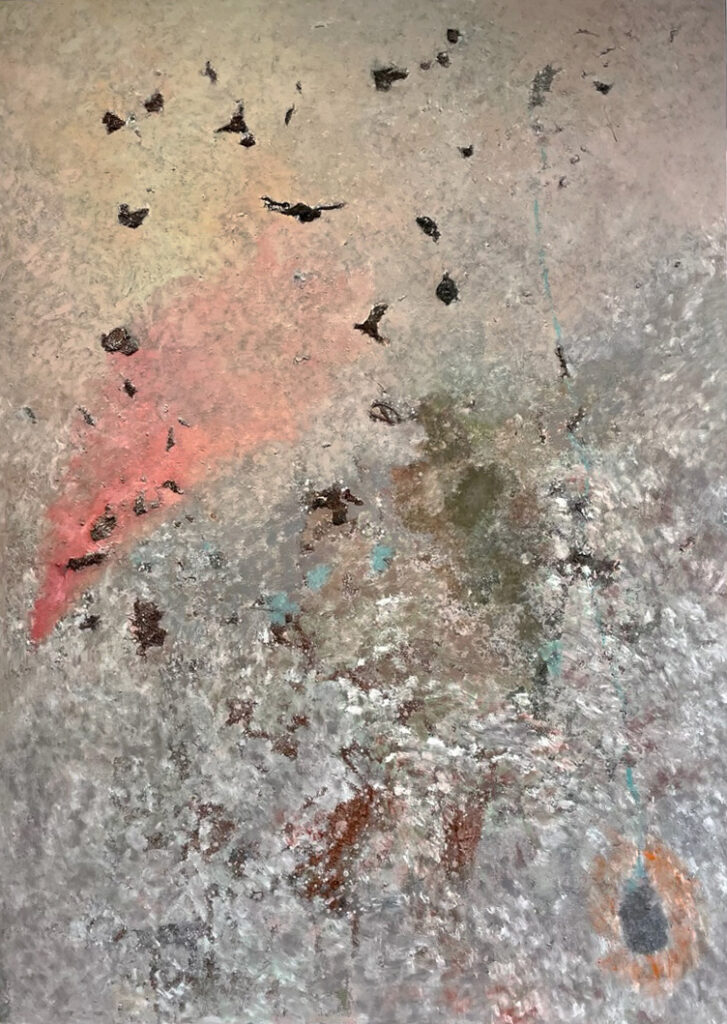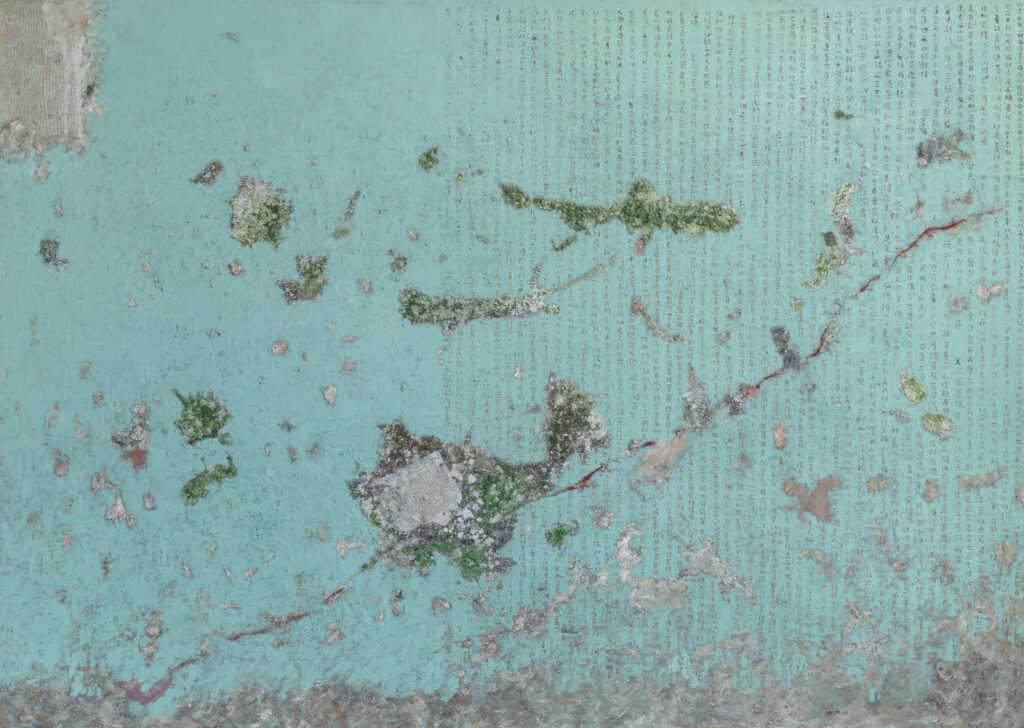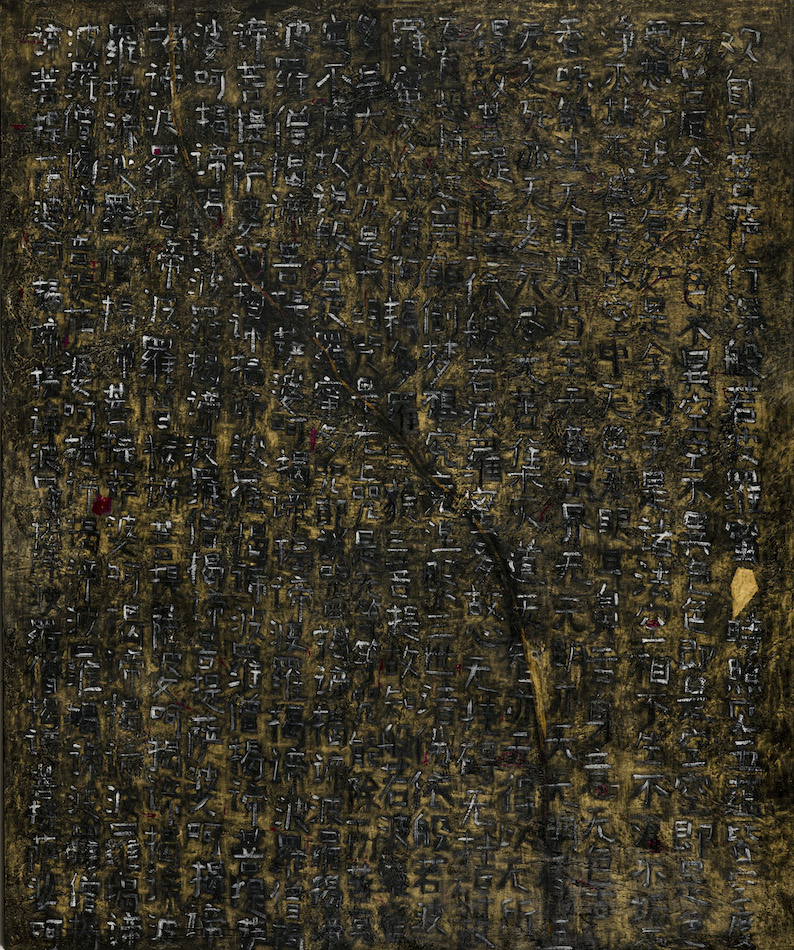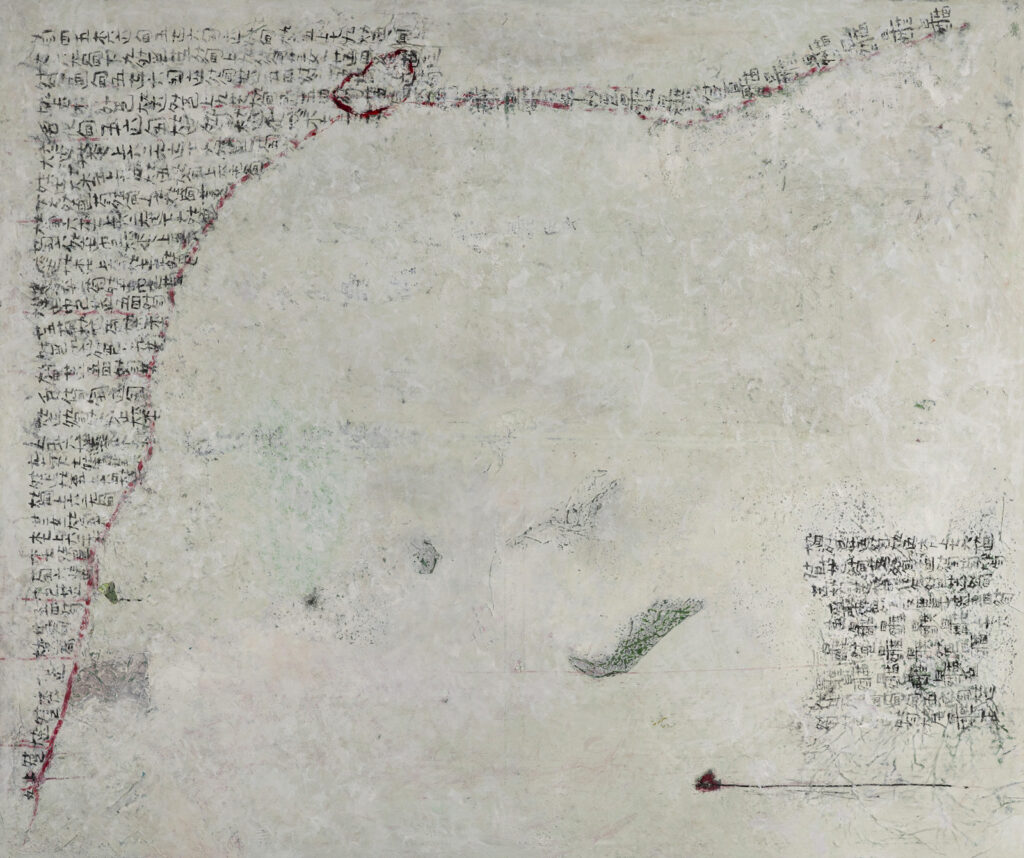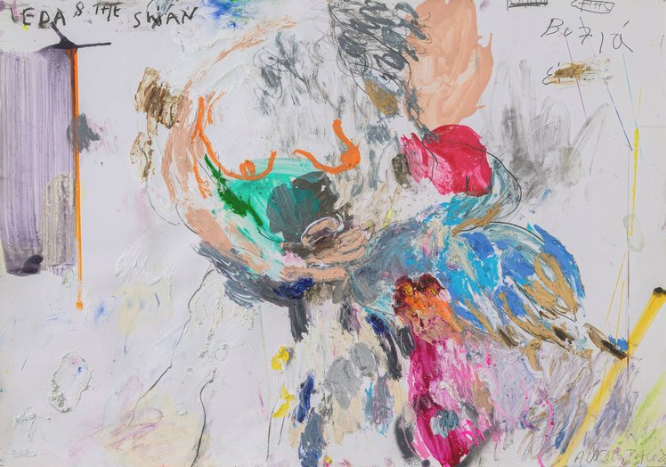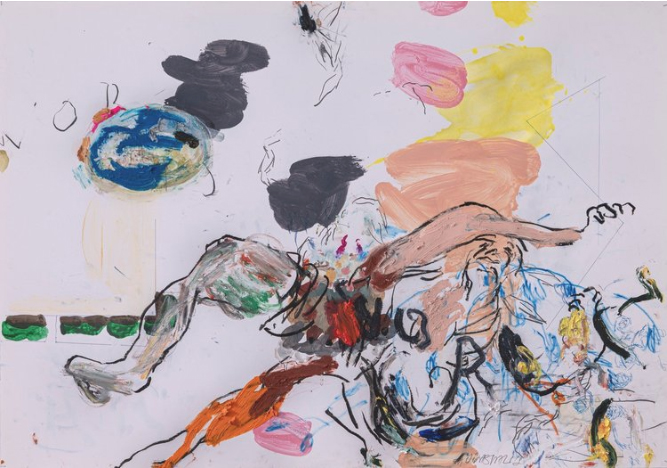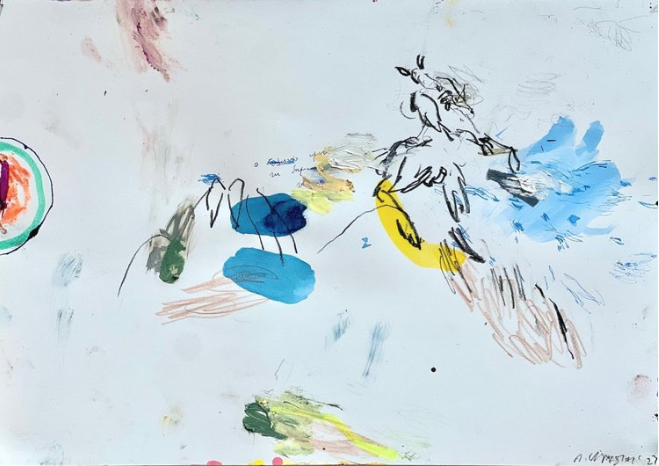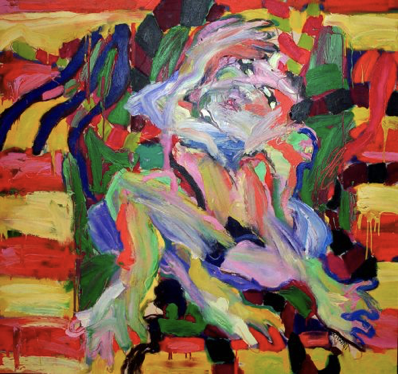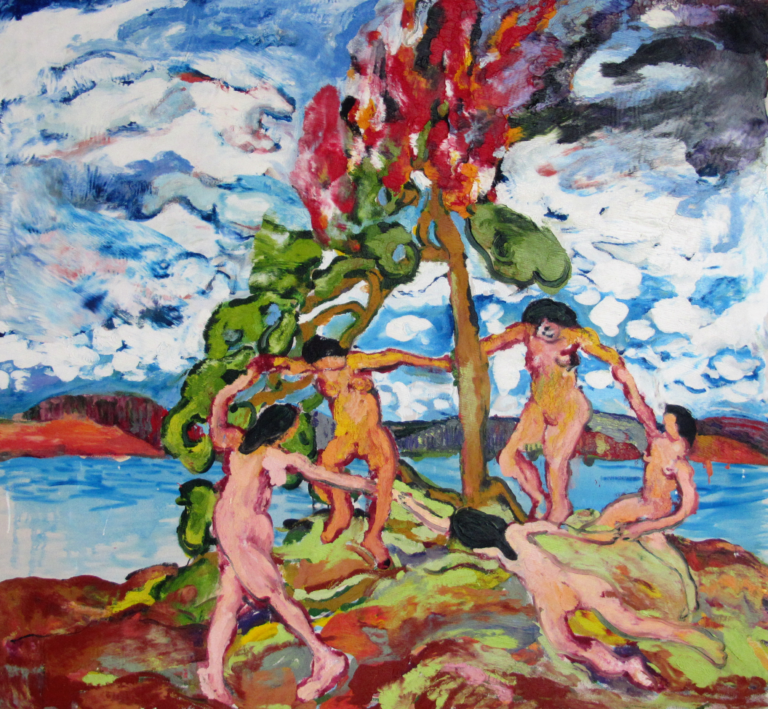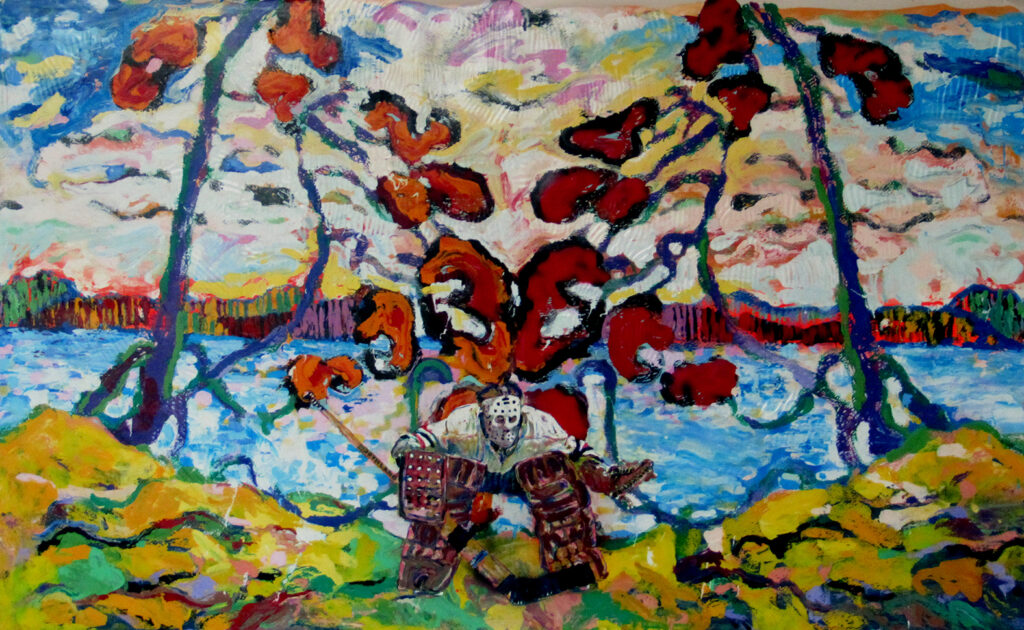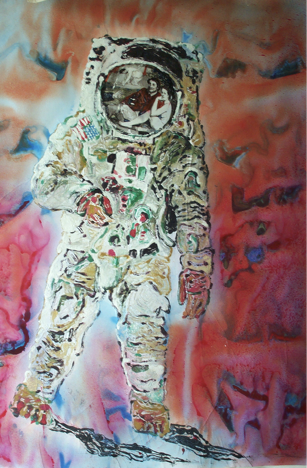by John Mendelsohn
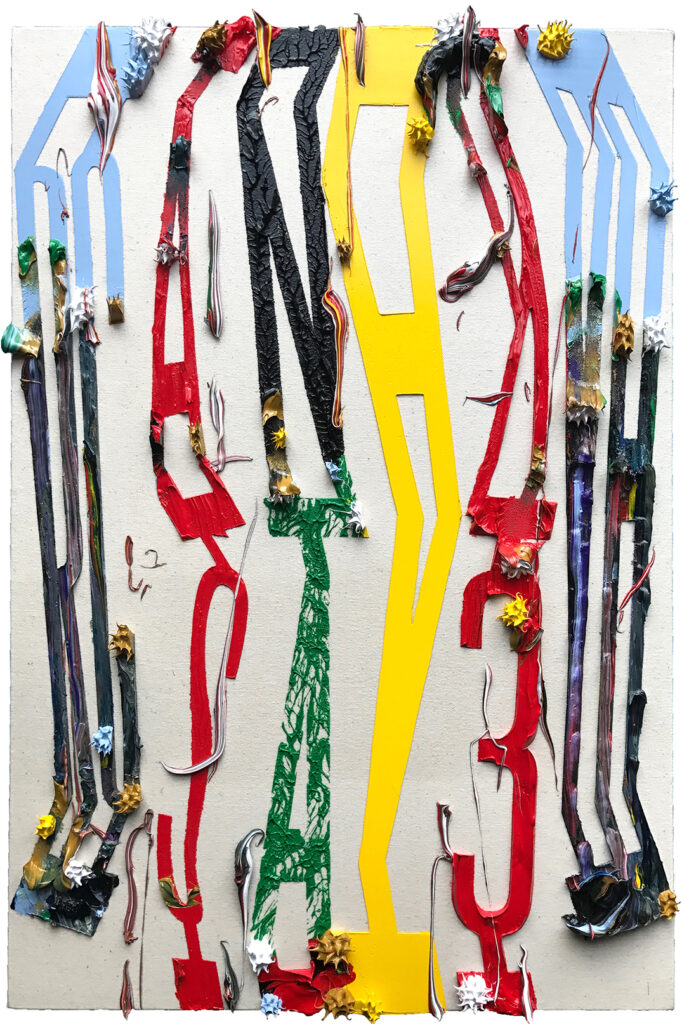
Perplexing, ingratiating, tricky – the paintings of Dennis Hollingworth are all these things and more. Most of the paintings in this exhibition date from 2016-2017, and will introduce some viewers to this intriguing artist’s work, last seen in in New York in 2019.
Hollingsworth primarily uses text in these works as a painterly motif and a cryptic language. A series of large words are stacked, elongated, turned inside out and backwards, and hung out to dry. The words take on a physical presence in thick relief, having been masked and painted on bare canvas, accompanied by fragments of patterns, and multicolored skeins of pigment.
The words exist on the edge of comprehensibility, as if we are hearing pressured speech or a transmission compromised by impinging forces. There is an aspect to this work that suggests concrete poetry or asemic writing. The former asserts the primacy of graphic form as means to convey poetic meaning. The latter uses the gestural qualities of writing as an abstract language in itself.
Both of these forms point to the central doubt in Hollingsworth’s work, a questioning of how or if language can communicate. With the words themselves windblown and torqued, they are like messages that cannot quite be grasped, but emphatic in their insistence in being heard.
Dennis Hollingsworth: Letters to the Future. Helm Contemporary, 132 Bowery, New York. December 15, 2023 – January 19, 2024
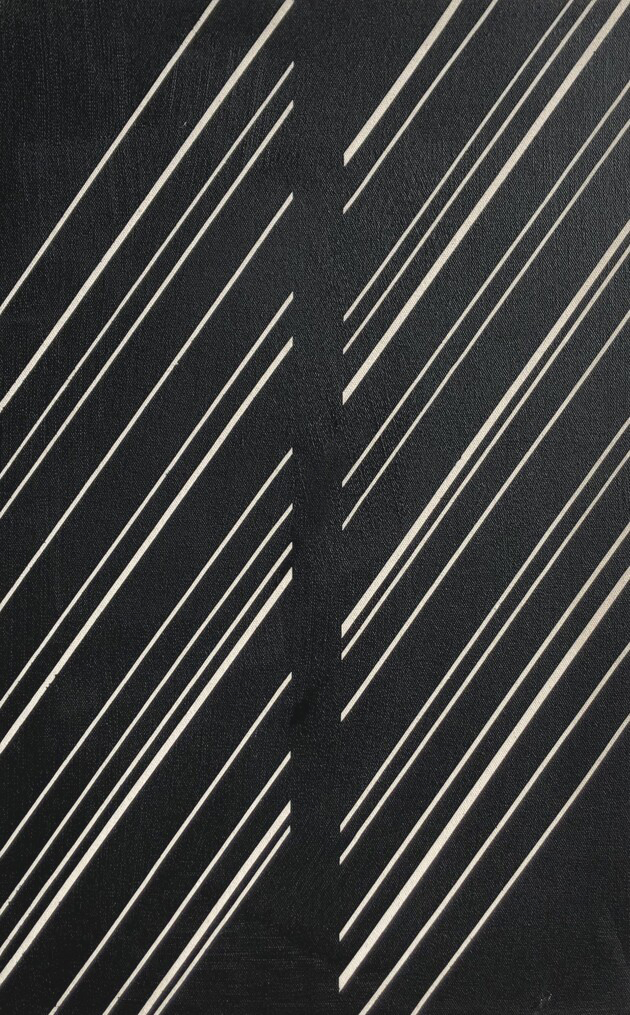
David Rhodes paints stripes in black and white. This bare description is both true and not true, in that it is what we see, and that it is not all that is there. This artist’s work is both physically embodied in black pigment on raw canvas and philosophically an enquiry into what constitutes the experience of a painting.
Within the strictures of diagonal lines of varying thicknesses, Rhodes allows patterns, rhythmic movement, and optical afterimages to emerge. The lines themselves are taped to a hard edge, but glitches occur, with minor bleeds and skips allowed to stand. At Helm Contemporary the paintings have dense, zigzagging, miss-matched sections, leaving us with the frisson of what should, but does not fit. And at High Noon the paintings, dominated by black, have a central, vertical black stripe – an empty zone, the void that cannot be filled, except by our own sense of rupture or relief.
The implacable quality of these paintings, with their uncompromising commitment to a singular vision, bring to mind the work of Clifford Still. The connection goes beyond the jagged forms, at times mountain-like and imposing, and rather suggests a similar existential journey, following a path inscribed in oneself that leads further and further into a spaciousness.
David Rhodes: Aletheia. High Noon Gallery, 124 Forsyth St., New York. January 18 – March 3, 2024
David Rhodes: Partita. Helm Contemporary, 132 Bowery, New York. January 26 – March 1, 2024
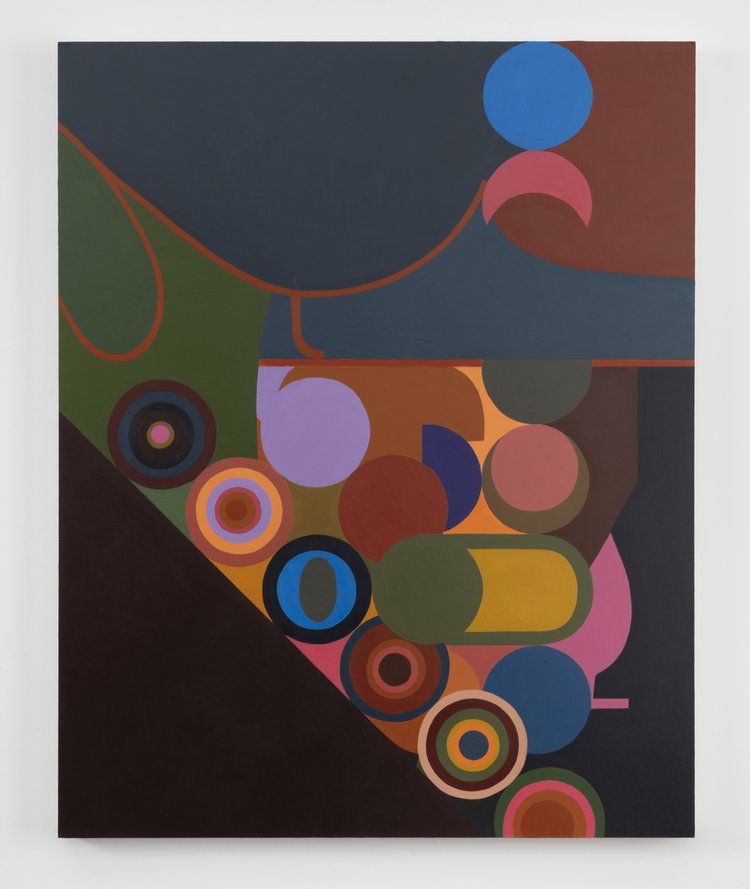
Mario Naves paints paintings. That is to say he aspires to make works that embody a kind of aesthetic resolution and solidity. In this intention he stand apart from the heady, supercharged possibilities that abstract painting currently offers. And in this there is a harking back to modernist models – think here about the work of Stuart Davis and Charles Demuth, and other painters of modern life, with the mechanistic and the graphic becoming worthy subjects of the artist.
But for Naves, the life he reflects seems infused with the technological, with its sheer surfaces that facilitate the seamless locking together of form and function. The facture is smooth and screen-like, with the shapes conforming to a kind of free-form geometry, a painterly choice that keeps any potential psychological mess at bay.
Yet at the heart of this work is a mystery. The curving shapes suggest silhouetted identities and personal scenarios that are encoded within the formal matrix. Disjunctive motifs – disks, stripes, flat vistas of color – are layered together, as if experience cannot be just one thing, but must always be various and contingent. The palette is bold, ranging from sonorous, saturated color to low down, unsaturated hues, and often with an insistent darkness as a recurring presence.
Mario Naves: Gratitude and Expectations. Elizabeth Harris Gallery, 529 W. 20th St, New York. January 6-February 17, 2024
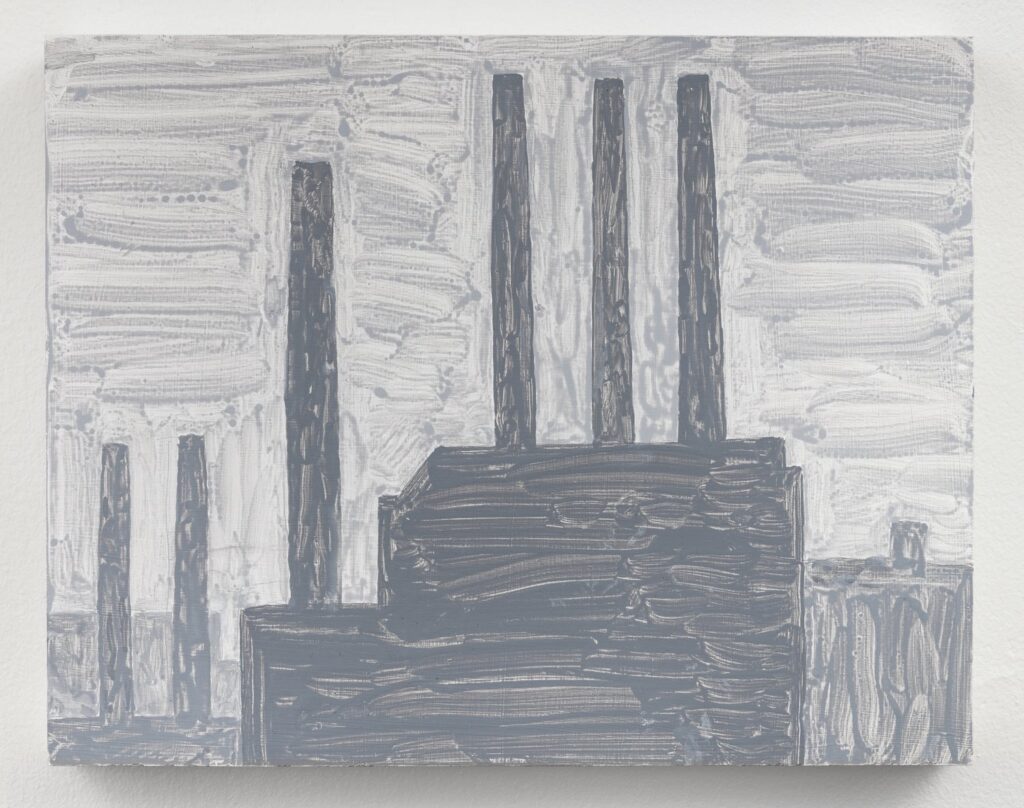
Photo: Adam Reich / courtesy of Elizabeth Harris Gallery
William Carroll is a walker in the city, specifically New York, and what he notices is what we see in his small-scale paintings. Working in transparent brushstrokes, primarily in tones of gray, or in two colors, he depicts vignettes of urban life. This is the perennial city, not the leviathan of glass-clad towers, but the unchanged town of rusted bridges, old churches, and empty bill boards with their bare scaffolding.
There is a persistent melancholy here, in the restrained tonalities and the unpeopled scenes of rooftops, power plants, and apartment buildings. In this focus, Carroll shares a poetic kinship with Edward Hopper, with their shared interest in the infrastructure of the city as a kind of surreal stage set which might hold the stories of the isolated and the dispossessed.
Carroll’s images are washy, with a direct, home-grown quality that sits at an angle with his minimalist sense of structure and reductive form. There is as well a gritty lightness at work here, a claiming of the modest and personal as having a place in the life of the metropolis. The paintings of the upper reaches of the city’s towers, each in two sherbet-like colors, are buoyant images that hint at the fulfillment that life there can also promise.
William Carroll: Living in the City. Elizabeth Harris Gallery, 529 W. 20th St, New York.
January 6-February 17, 2024
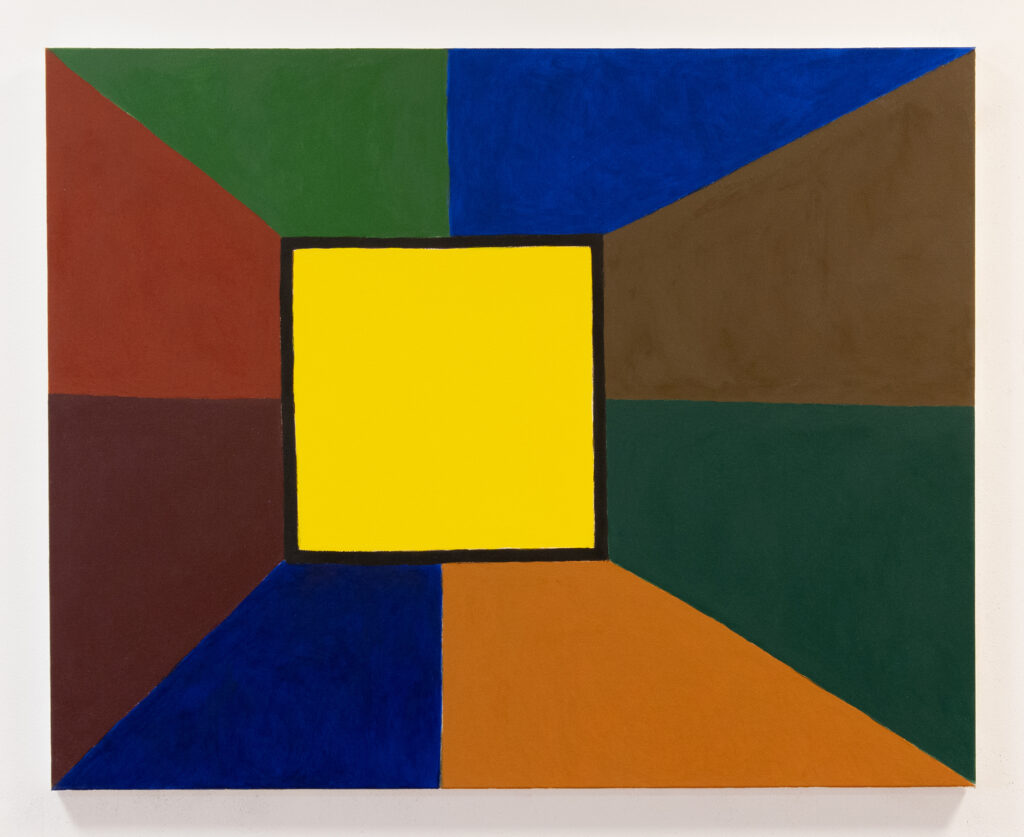
In her exhibition, Portraits of Squares, Harriet Korman (full disclosure: my spouse), extends her pursuit of painting that is abstract and structured, but activated by color and by the feeling that we are encountering a consciousness at work. Here are ten recent works, all 24×36 in., made of intuitive, hand-painted geometric forms, with the emphasis on a single square. One canvas from 1979 is also being shown. In the work from the last two years, the square is set within a matrix which varies from concentric bands, to a grid of squares and rectangles, to a perspectival vortex. The square that is the subject of each “portrait” is thus both an independent entity with its own character, and emergant from the life which engendered it.
The mood in these works is by turn introspective and declarative, with a willingness to let the works’ basic elements take the artist on a trip to the inner life of geometric painting. There we sense distant echoes of ancestors: Mondrian and Albers, traditional quilts, and other, older forms of abstraction. But what is most compelling is that with the plain means at hand – resonant color and formal composition – this artist has created a visual fugue that unfolds like music.
Harriet Korman: Portraits of Squares. Thomas Erben Gallery, 526 W. 26th St., New York. January 18 – March 2, 2024
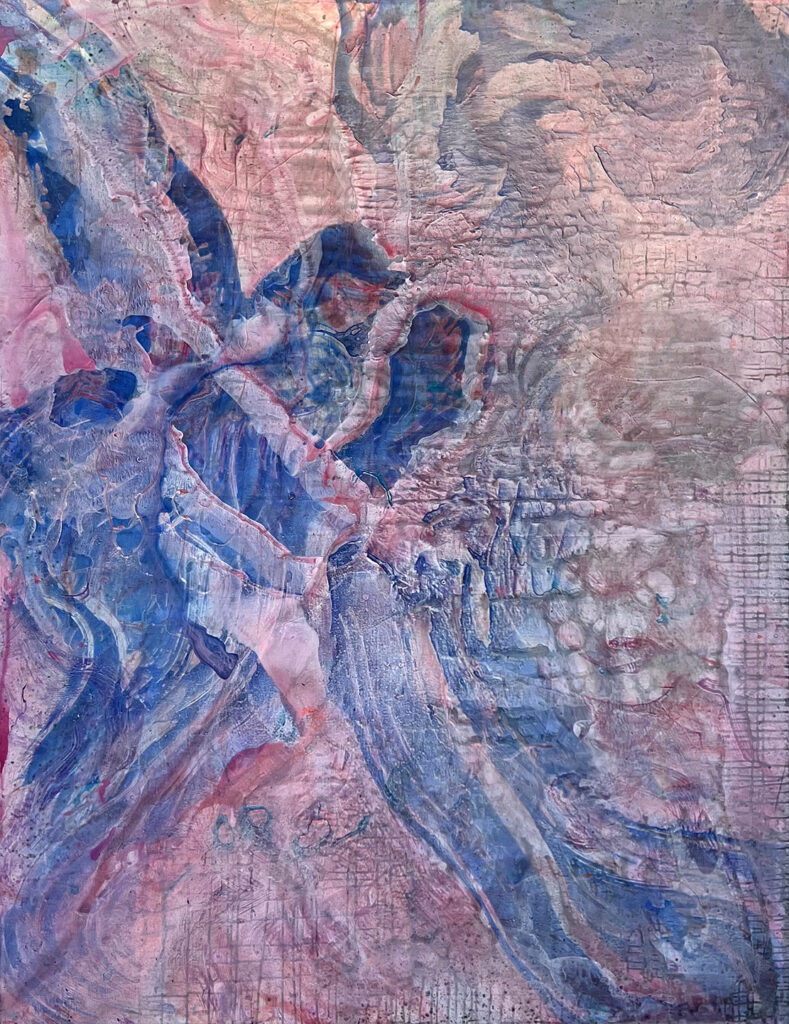
“Psychedelic” is a word that lately is much in the air, particularly in regard to the therapeutic use of psychoactive substances. It carries forward the traditional practice of mind-expansion via hallucinogenics that re-emerged in the 1960s. Daniel Rosenbaum’s paintings feel like they are part of this perennial, conscious-raising project. His vehicle is just paint on canvas, and the faith that abstraction is like a drug that goes right to brain, bypassing rational thought.
Rosenbaum’s paintings in this two-part exhibition range from works that evoke figural imagery to purely abstract engagements. Throughout are flowing currents of visual energy – rippling linear patterns that create nests of involuted loops and liquid unfurlings. We sense that the mutable nature of paint and Rosenbaum’s physical immersion in it constitute the works’ central drama. A painting’s image arises both spontaneously, and with the visible direction of the artist’s hand. Paint streams and pools, and moves with gestural writhings, becoming in itself a kind of animated body.
The body appears literally in a number of the paintings, including a comet/human hybrid, an archangel with reaching wings, and figures from a Renaissance painting. In two abstract canvases, each about 7-feet tall, Rosenbaum is able to expand his vision of cascading floods of color, which through sensitive layering take on an almost topographical presence, to evoke a watery realm and an airborne spirit.
Daniel Rosenbaum: Inner Guardians, Outer Explorers. Woodward Gallery, 132A Eldridge St. and Down Town Association, 60 Pine St., New York. January 12 – March 31, 2024

